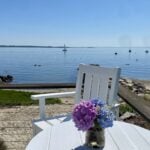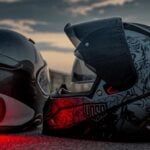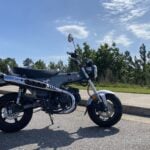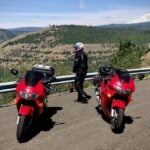Riding While The World Burns
Here in the upper left of the United States, it’s the end of the world as we know it.
It started with an idyllic Labor Day as clear Pacific Northwest air stirred blue skies, a stiff warm breeze playing in the trees. Then the world caught fire.
By the end of the day over 80 separate fires across Washington alone had burned over 300,000 acres, an area about half the size of Rhode Island. In one day, it burned more land than any of the past twelve fire seasons. The smoke instantly turned the sun blood red as ash the size of dimes fell like snow around me. Walden, a small town east of my home in Wenatchee, was almost wiped off the map by the fire. Oh, and we are also in the grip of a pandemic. A plague of locusts is likely not far behind.
Few places in the United States remind a resident that the land is in charge as much as the Pacific Northwest. We are no stranger to these fires, or blizzards, avalanches, drought, floods, earthquakes, volcanic eruptions, tsunamis, Bigfoot sightings and a Super Bowl celebration gotten out of hand. It turns residents into rugged yet caring individuals and few are as tough and caring as the “wild land firefighters.”
Being a first responder, I know them. They are the badasses with a thin frame, a thick beard, a chainsaw on their shoulder and swagger in their stride. Job one for them is to care. Everything else stems from that sole trait: putting out a fire, being in peak physical condition, even knowing the land personally all stems from wanting to save someone or something because they care and in their valor lies our hope.
The stories you hear about these wild land firefighters risking their lives to save a person, a building, a dog or even a stray cow stuck in barbed wire while flames lick their heels are all true and all common. Every firefighter I know is capable of such heroics because their primary job is to save: save an animal, save a building, save a person and sometimes save each other.
Riding a motorcycle through the smoke is surreal. Riders in our Mild Hogs touring group came from four separate towns scattered across the state in an attempt to find refuge in one of the few places not permeated by smoke. For one night, our meeting spot of The Ruby Creek Lodge in Cusick, Washington provided a refuge from the world going to hell. Briefly, all was bliss. It didn’t last long.
Before and after shots upriver and downriver show a clear Pend Oreille River Friday night, then smoked in by Saturday morning. But to the northwest native, we fish regardless.
The power went out that night, bathing us in darkness so thick blinking made no difference. Eyes closed, eyes open, it was all the same. Morning provided little light because by then, the smoke had come. An idyllic river view of the Pend Oreille River was now blanketed in smoke so thick visibility was limited to half a mile. We rode regardless.
Well, some of us did. After an attempt at riding the local roads, some turned back. No shame or ridicule came about because those that turned back were the sane ones.
Riding a motorcycle in smoke this thick is bizarre. Limited visibility makes passing either questionable or impossible. There is also the risk of outriding your vision, of going so fast that by the time you see the black bear in the road you have no time to stop (it happened, the bear was huge, and we did stop in time). And the faster you ride the more the smoke particulates get shoved into your helmet vents making breathing extremely interesting and eye lubrication a struggle. After a few hours, soot was so firmly stuck to my riding gear it appeared I had bathed in dirt.
Soot accumulation on my black gear makes it all brown. All of it is picked up by just riding through it.
During a break Trevor Alexander, our tail gunner, and I walked into the local Safeway, both of us bathed in soot and looking ragged enough that patrons asked if we were firefighters. Sorry ma’am, but no, those guys are heroes. Us? Well, we’re just too stubborn to quit riding motorcycles.
Yet, that stubbornness is the Pacific Northwest way. We live our lives among the evergreens that provide for us then burn all around us, the volcanoes that impress then devastate, the snowpack that kills then provides precious water through the summer, the juxtaposition of a land that gives life and then takes it away. Living with the land here is not for the timid, a trait proved true by, of all strange things, a tunnel.
After coming to our senses and riding back to the lodge, Trevor and I stubbornly refused to go inside and braved the smoke for a walk on the nearby abandoned railroad tracks where we discovered the tunnel.
Built in 1909 by Idaho and Washington Northern Railroad, it is a testament to northwest toughness. It’s almost a quarter mile long, 16 feet wide and 24 feet high and was dug and dynamited by hand.
Exploring is a hard habit to break, even if it means going under a fence into an abandoned tunnel through smoke filled air while wearing flip-flops.
Yes, by hand. All the drilling, all the blasting, all the digging done by hand and completed in only six months. Evidently the shift boss for the project was not a popular fellow so after the tunnel was completed and the opening celebration was over, he vanished. The river was dragged and dynamited for his body (really?) with no luck. Thee months later, his body finally appeared a mile and a half down river. By then no one cared and every one had left the construction site anyway, so the matter was dropped.

It doesn’t take much imagination to go back in time up here.
Exploring the the smoke filled tunnel was eerie. Dripping water from the soil above oozed between the massive wood beams and onto the tracks, echoing each splash into the darkness. The dank smell of the stale moist air mixed with the smoke made it smell like a fresh house fire. As I lit the darkness with my cell phone light, Trevor and I marveled at the man hours and toughness it took to bore a hole through the mountain by hand, prop it up with timber and have it still stand 110 years later. On the wall appeared prophetic graffiti: enter at your own risk.
Yes, enter at your own risk. True of the tunnel, true of the Pacific Northwest in 1909, and true today now more than ever.
As I write this, visibly is down to three houses. Somewhere out there, firefighters are sacrificing their bodies and minds, struggling to save the strangers they care about and the land they live in. This is happening up and down the west coast, from Washington, through Oregon, all the way to San Diego, California. So great is their burden, so taxing is the mental and physical toll of what they see and do that in 2017 more wild land firefighters died by suicide than actually fighting the fires. It’s hard to comprehend this dedication to the land unless you live here.
But I wouldn’t live anywhere else.
Ted

Satellite photo by NASA Earth Observatory































The concrete bank safe out front of the resort. Part of the main house was the school teachers residence. Evidence of life past is always a good time to reflect.
Yes it is, Jeff. Thanks for commenting,
The higher we climbed up Tiger Pass the worse the visibility got and it started to snow. Hey, that’s not snow…..it’s a gentle dusting of ASH! Several of us turned back to our “cleaner ” valley that by the time we got back was totally overrun by thick acrid smoke. The forcasted cloudless skies with 80 degree temps was supplanted by a “nuclear winter” that completely obliterated the sun and kept the temperature hovering in the high 50s to low 60s . Complaining? Not on your life! Riding and “hanging” with the motley porcine crew made it all worth it!